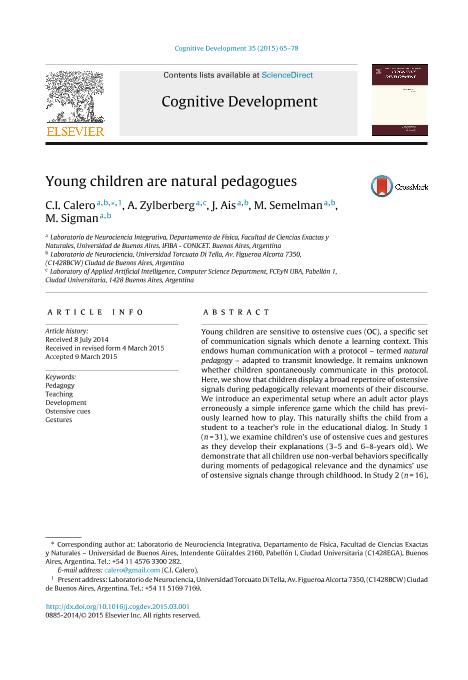Artículo
Young children are natural pedagogues
Fecha de publicación:
09/2015
Editorial:
Elsevier Inc
Revista:
Cognitive Development
ISSN:
0885-2014
Idioma:
Inglés
Tipo de recurso:
Artículo publicado
Clasificación temática:
Resumen
Young children are sensitive to ostensive cues (OC), a specific set of communication signals which denote a learning context. This endows human communication with a protocol – termed natural pedagogy – adapted to transmit knowledge. It remains unknown whether children spontaneously communicate in this protocol. Here, we show that children display a broad repertoire of ostensive signals during pedagogically relevant moments of their discourse. We introduce an experimental setup where an adult actor plays erroneously a simple inference game which the child has previously learned how to play. This naturally shifts the child from a student to a teacher's role in the educational dialog. In Study 1 (n = 31), we examine children's use of ostensive cues and gestures as they develop their explanations (3–5 and 6–8-years old). We demonstrate that all children use non-verbal behaviors specifically during moments of pedagogical relevance and the dynamics’ use of ostensive signals change through childhood. In Study 2 (n = 16), the adult pupil minimizes all reception to non-linguistic OC and gestures. This resulted in a decrease of children's frequency of OC during pedagogical episodes but did not affect other gesturing behavior. In Study 3 (n = 15) we show that decreasing ostension during children's history of instruction does not decrease their own ostension while teaching. This rejects the hypothesis that children teach by simple imitation of their learning experience and showed instead, that they can diagnose the sources of the adult pupil's failure and adjust their own teaching accordingly. Together, these results demonstrate that children are spontaneously tuned in the emitter side of natural pedagogy.
Palabras clave:
Pedagogy
,
Teaching
,
Development
,
Ostensive Cues
,
Gestures
Archivos asociados
Licencia
Identificadores
Colecciones
Articulos(IFIBA)
Articulos de INST.DE FISICA DE BUENOS AIRES
Articulos de INST.DE FISICA DE BUENOS AIRES
Citación
Calero, Cecilia Ines; Zylberberg, Ariel Dario; Ais, Joaquin; Semelman, Mariano; Sigman, Mariano; Young children are natural pedagogues; Elsevier Inc; Cognitive Development; 35; 9-2015; 65-78
Compartir
Altmétricas




